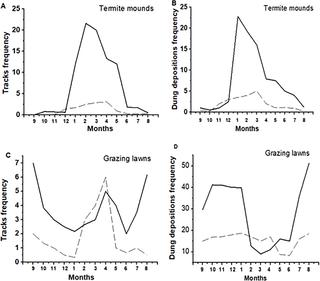PLOS ONE ( IF 2.9 ) Pub Date : 2020-03-30 , DOI: 10.1371/journal.pone.0230192 Gabriel Mayengo 1, 2 , Alex K Piel 3 , Anna C Treydte 1, 4

|
While movement patterns of grazing ungulates are strongly dependent on forage quality their use of nutrient hotspots such as termite mounds or grazing lawns has rarely been quantified, especially in savanna ecosystems where soil-nutrient quality is low. Additionally, few experiments have been conducted to determine the role of termite mound- and grazing lawn-derived soils in improving forage quality in the field. We studied wild ungulate grazing activities around ten termite mounds, six grazing lawns and their respective control sites in a Miombo system of Issa Valley, western Tanzania, in the same system. We used indirect observations (i.e., dung, tracks) to identify seasonal and spatial variations in habitat use of various wild mammalian grazers. Grazer visitation rates were nine and three times higher on termite mounds and grazing lawns, respectively, compared to control sites. During the rainy season, termite mounds were more frequently used than grazing lawns while the latter were used more often during the dry season. In an additional pot experiment with soils derived from different areas, we found that Cynodon dactylon in termite mound-derived soils had twice as high Nitrogen and Phosphorous contents and biomass compared to grasses planted in grazing lawn soils and control site soils. We highlight that both termite mounds and grazing lawns play a significant role in influencing seasonal nutrient dynamics, forage nutrient quality, habitat selectivity, and, hence, grazing activities and movement patterns of wild ungulate grazers in savannas. We conclude that termite mounds and grazing lawns are important for habitat heterogeneity in otherwise nutrient–poor savanna systems.
中文翻译:

坦桑尼亚Miombo生态系统中养分热点对放牧有蹄动物的重要性。
尽管有蹄有蹄类动物的运动方式在很大程度上取决于草料质量,但很少量化白蚁丘或放牧草地等养分热点的利用,特别是在土壤养分质量低的稀树草原生态系统中。另外,很少进行实验来确定白蚁丘和放牧草坪衍生的土壤在改善田间草料质量中的作用。在同一系统中,我们研究了坦桑尼亚西部Issa Valley的Miombo系统中十只白蚁丘,六个放牧草坪及其相应控制点周围的野生有蹄类动物放牧活动。我们使用间接观察(即粪便,田径)来确定各种野生哺乳动物放牧者栖息地使用的季节性和空间变化。在白蚁丘和放牧的草坪上,Grazer的探访率分别是九倍和三倍,分别与对照地点进行比较。在雨季,白蚁丘的使用比放牧草坪的使用更为频繁,而在旱季,白蚁丘的使用更为频繁。在另一个针对来自不同地区的土壤的盆栽实验中,我们发现狗牙根在白蚁丘衍生土有两倍氮,磷含量和生物质相比,种植草坪放牧土壤和控制现场的土壤草。我们强调白蚁丘和放牧草坪在影响季节性养分动态,牧草养分质量,生境选择性以及因此在热带稀树草原上的有蹄类动物放牧者的放牧活动和运动模式中都起着重要作用。我们得出结论,白蚁丘和放牧草坪对于原本缺乏养分的稀树草原系统中的生境异质性至关重要。











































 京公网安备 11010802027423号
京公网安备 11010802027423号